|
Module 19 |
Updated: 07/20/2005 |
|
Creative Control In addition to the focus, iris, and color balance adjustments on camcorders, most video cameras have an adjustment for shutter speed. Knowing how to use shutter speed is another example of a creative control that can make the difference between good video and poor video-and separate the amateurs from the professionals. Unlike the shutters used in still cameras, the shutter used in most video cameras is not mechanical. Chip camera "shutter" speeds simply represent the time that the light-induced charge is allowed to electronically build in the chip before the cycle is repeated. With speeds as high as 1/12,000 second in some consumer camcorders, almost any movement can be "frozen" without blur or smear-speeding cars, golf balls, or hockey pucks. If you think of dividing a second into When we move to these speeds we can see things in new ways. For example, an ultrahigh speed exposure (achieved with special equipment) was used to show this bullet going through an apple. |
|
By setting a video camera to a "normal"
shutter speed of 1/60th second (the time it takes to scan one video field in the
NTSC standard), the electronic sampling is done at the maximum time allowed by the
field rate of the TV system. This represents the maximum exposure possible with
normal sampling. In this graph the bars represent total exposure at various shutter speeds. In very low light conditions the shutter speed on some video cameras can be slowed down to allow much more light to register on the chip (the bars below 1/60th second in the graph). Although this results in much brighter video, if there is any action, a jumpy, stroboscopic effect will be obvious. If there is a need to stop (freeze) action, faster shutter speeds than "normal" can be selected. Most professional video cameras have a series of shutter speeds from of 1/60 second (normal), to 1/2,000th second. Many go beyond this to 1/5,000, 1/10,000th, and, as we've noted, even 1/12,000 second. At the same time, note in the graph above how this reduces the
total light on the chip (exposure). To compensate, the iris of the lens must
be opened up. The higher speeds (1/1,000th and above) make possible clear slow-motion playbacks and freeze-frame still images, such as the one we see here.
Just as in traditional still photography, with video cameras there is a direct relationship between shutter speeds and f-stops. Each of the combinations in the table below represents the same exposure (total light on the chip). Typical Relationship Between
You will note from the table above that each time the shutter speed is doubled, the lens must be opened up one f-stop to provide the same net exposure. (The increased shutter speed cuts the exposure time in half, but opening the iris one f-stop lets twice as much light through the lens to compensate.) The combinations shown in the above table are for a scene with a specific amount of light. A different scene may call for an exposure of 1/100 at f/4 instead of f/11, for example, and then all of the other shutter speed and f-stop relationships will shift accordingly. The variable we are holding constant in this example is the light sensitivity of the camera. However, keep in mind that this can also change, and that would introduce a completely different shutter speed/f-stop scale. These f-stop and shutter speed numbers
may seem confusing at first, but once you get them in mind, they will serve you
well in video, still photography, and even in motion picture work. It's all the
same, and it has remained essentially unchanged worldwide for well over a century.
(And, in case you need it, you will recall that
A stroboscopic effect (where you see a rapid sequence of discrete images associated with movement) can occur in video cameras with very high (above 1/250th second) and very low (below 1/60th second) shutter speeds.
Just like a time exposure in still photography, it's possible in some video cameras, as we've noted, to use exposure rates below the normal 1/60th second. As we've previously noted, this allows the effect of the light to build in the CCD beyond the normal scanning time. But the catch is that in this process some fields and frames are omitted (ignored) at regular intervals. If no movement is involved, the loss of frames will go unnoticed.
Note the separate images in photo on the left and the jerky
motion in the reel Besides the (somewhat questionable) special effect this provides, there are occasions-primarily very low light news and documentary situations-where imperfect video is better than no video at all.
Now let's consider the other end of the shutter speed range. When shutter speed intervals shorter than 1/250th second are used, action tends to be cleanly frozen into crisp, sharp, still images. Without the slight blur that helps smooth out the transition between successive frames, we may notice a subtle stroboscopic effect when we view rapid action. Even so, the overall effect is to make images clearer, especially for slow-motion playbacks. Video cameras dedicated to slow motion (slo-mo) applications can be speeded up to between 100 and 200 frames per second with correspondingly high shutter speeds. By slowly playing back footage taken at this speed, you can study sharp, discrete slices of the action. To see the difference that shutter
speeds can make in stopping action, study the following sequence of roller coaster
photos. The first was taken at 1/30 second, the second at 1/100th second, the third
at 1/500th second, and the final photo at 1/1,000 second.
A final note on shutter speeds. When taping under fluorescent lights, it's advisable to stick to a 60th second (normal) shutter speed. Using a faster shutter speed typically results in a flickering effect in the video as the chip exposure interval interacts with the normal flicker of fluorescent lights.
As we noted in Module 8, the normal frame rate for video cameras is 30 per-second or 25 per-second, depending on the country. However, the latest generation of professional video cameras can be overcranked or undercranked.
In the process of speeding up the frame rate, the shutter speed of the camera was also shortened, requiring either more light or a wider f-stop. (Refer back to the earlier discussion on shutter speeds and exposure.) If the motion picture camera was undercranked, the frame rate was slowed down. This speeded up the action on playback (and, as you would assume, increased the exposure on the film). Even when electric motors replaced cranks, film cameras retained the ability to speed up or slow down frame rates, and they retained the terms "overcranked" and "undercranked." Film personnel seem to hang on to their terms throughout the years, even though new technology comes along; whereas, video personnel seem to be willing to-or maybe have to-adjust to new terms on a regular-some would even say, monthly-basis!) Although we often see obvious slow-motion effects and even scenes that are speeded up for effect, sometimes the intent is more subtle. For example, a scene may be slightly undercranked (resulting in a slight increase in action speed) to add intensity and frenzy to a scene. Or, the camera may be overcranked to slightly slow down action and add a subtle fluid motion to a scene. The latest generation of high-definition video cameras can be adjusted to 24 frames per-second (the normal film speed) and the result readily converted to 35mm or 16mm motion picture film. When the proper equipment is used, the image quality is virtually indistinguishable from images originally shot on film. As we've noted, many TV series and some feature "films," are now being shot in 24P (24 frames per-second, progressive scan video). |
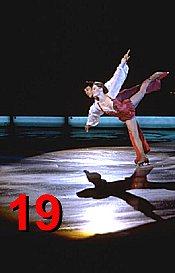
 12,000
parts and then allowing the image to be exposed for only one of those 12,000 intervals
you get an idea of just how fast this is.
12,000
parts and then allowing the image to be exposed for only one of those 12,000 intervals
you get an idea of just how fast this is.
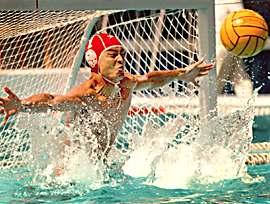
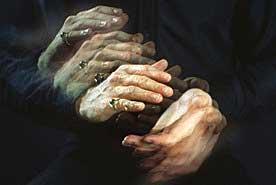 However,
with movement the loss of frames results in a discontinuity in action and a jerky,
stroboscopic effect.
However,
with movement the loss of frames results in a discontinuity in action and a jerky,
stroboscopic effect. on the right.
on the right.

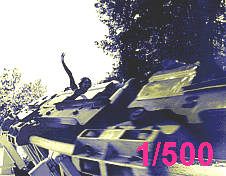
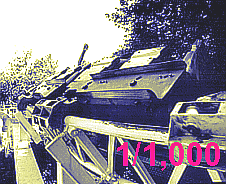
 The
"cranking" term originated with film back in the early 1900s when motion picture
cameras had to be cranked by hand. (One of the earliest motion picture cameras is
shown on the left.) Since film projectors were supposed to be operated at a set
speed, if the film camera was overcranked and the frame
rate was speeded up, the action was effectively slowed down when the film was later
projected at normal speed.
The
"cranking" term originated with film back in the early 1900s when motion picture
cameras had to be cranked by hand. (One of the earliest motion picture cameras is
shown on the left.) Since film projectors were supposed to be operated at a set
speed, if the film camera was overcranked and the frame
rate was speeded up, the action was effectively slowed down when the film was later
projected at normal speed.